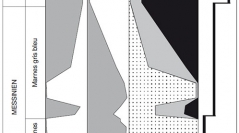

 Geodiversitas
30 (1) - Pages 97-116
Geodiversitas
30 (1) - Pages 97-116The biostratigraphical analysis of the Miocene-Pliocene series, established from planktonic foraminifera allowed to recognize two different lithologic successions. At the platform (Sassel), the stromatolites of Messinian age are surrounded by lower Pliocene sandy marls (Zanclean), with an erosional unconformity. At the basin center (Sidi Brahim, Sidi Bel Attar), gypseous conglomerates constitute the base of sandy and grey marls sedimentation. This succession is surrounded by white marls, similar to the Trubi facies of Zanclean. The paleoenvironmental analysis of benthic foraminifera and ostracods assemblages firstly shows a confining regime, followed by an intra-Messinian marine pulsation. In the basin center, this event is marked by the change from sandy marls corresponding to a high salinity infralittoral environment, to the grey marls indicating deeper circalittoral environment. However, on the platform, the stromatolitic construction was exposed to an erosion event and finally, shows a ravinement surface at the top. At the Zanclean, the Chelif Basin records a brutal marine transgression flooding until the deepest areas of the basin center where white marls of Zanclean are located. The diversified and rich biofacies differ from the Messinian with characteristic microfauna indicating bathyal environment. On the platform, an infralittoral environment is recorded.
Algeria, Messinian, foraminifera, paleoenvironnement, messinian salinity crisis